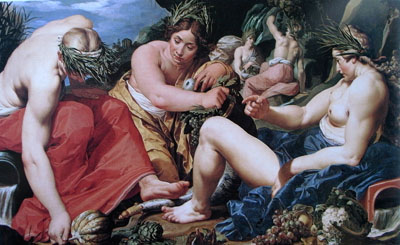During the Late Renaissance, 16th century, ideals shifted which resulted in Mannerism. The styles of the High Renaissance where figures are perfected are no longer perfect in Mannerism. Most art created during this time is often viewed as unsettling due to the new styles. Two paintings in the permanent collection of the Seattle Art Museum
The Origin of Cornucopia, 1619, embraces in many ways Mannerism. Unrealistic body proportions are a mannerism style. This painting has slight elongation; this may be from the way the bodies are positioned in such exaggerated poses where the figures are twisted in ways that appear rather uncomfortable. The figure’s gestures create a movement throughout the painting. Each character is moving in direction or another. Some limbs appear elongated to create emphasis on their movement. Pontormo’s Descent from the Cross, 1525-1528, has figures that create movement in the same gestured way as Janssens’ painting. The Origin of Cornucopia has what some people would call erotic imagery because there are shirtless nymphs being portrayed. Mannerism paintings frequently have unusual colors, the Descent from the Cross has unusual colors when bright pink is utilized for a figure’s back juxtaposed to it is a vivid blue for his stomach. Janssens’ painting does not have any unusual colors or juxtapositions. The Origin of Cornucopia has beautiful colors much like paintings of the High Renaissance. There is a good balance of light and dark contrast. This painting is not as visually unsettling as Leda and the Swan and her Children.
The painting of Leda and the Swan and her Children, 1540, conveys Mannerism more so than The Origins of Cornucopia. The figures portrayed have unrealistic body proportions. The figure’s bodies are elongated for example Leda’s torso and hands. Unlike Janssens’ and Pontormo’s none of the figures emphasize movement in this painting of Leda and the Swan and Her Children. The figures appear rather still except the child that is hanging on Leda’s shoulder who seems like he’s attempting to get Leda’s attention. There appears to be a lack of balance, the figures seem packed into the painting. I say this because Leda is resting her right arm on the swan’s neck, which is rather unsetting. The emotions seen in this painting are kind of disturbing. Leda appears withdrawn from her children. The three children convey almost scary with their weird faces. The contrast of light and dark contribute to the weird vibe, Leda’s face and chest are too light. There is some erotic imagery in this painting. Leda is half naked and is not being very modest.
The painting of Leda and the Sawn and her Children appears more unsettling than the Origins of Cornucopia painting. This may be because the painting of Leda and the Sawn and her Children painted by Vincent Sellaer in 1540, which is more towards the beginning of the shift in ideals. Janssens painted the Origins of Cornucopia in 1619, which is early 17th century perhaps when ideals start the shift again.



Taylor: I agree that "Leda and the Swan and Her Children" is quite an unsettling painting, especially when compared to "The Origins of Cornucopia." I also hadn't realized that Leda was resting her arm on the swan's neck until you pointed it out. ~Lacey
ReplyDeleteI like how you hit all parts of mannerism to make sure you accuratly described it. For example, with the first painting you talk about the figures shapes, then the colors. Another thing I like is how you wrote that some people though of it as erotic because I didnt know that since it didn't really seem that way to me.
ReplyDeleteJennifer Groce